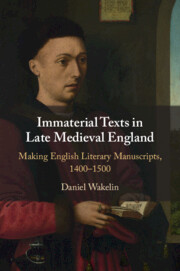Book contents
- Immaterial Texts in Late Medieval England
- Immaterial Texts in Late Medieval England
- Copyright page
- Epigraph
- Contents
- Figures
- Acknowledgements
- Abbreviations, Quotations and References
- Chapter 1 Prologue
- Chapter 2 ‘Hele alle maner of schabbis’
- Chapter 3 ‘Who by prudence Rule him shal’
- Chapter 4 ‘Þe leef torned’
- Chapter 5 ‘Rede … and ʒe may se’
- Chapter 6 ‘This is the copy’
- Chapter 7 Conclusions
- Bibliography
- List of Manuscripts
- General Index
Chapter 6 - ‘This is the copy’
Reproducing the Immaterial
Published online by Cambridge University Press: 12 May 2022
- Immaterial Texts in Late Medieval England
- Immaterial Texts in Late Medieval England
- Copyright page
- Epigraph
- Contents
- Figures
- Acknowledgements
- Abbreviations, Quotations and References
- Chapter 1 Prologue
- Chapter 2 ‘Hele alle maner of schabbis’
- Chapter 3 ‘Who by prudence Rule him shal’
- Chapter 4 ‘Þe leef torned’
- Chapter 5 ‘Rede … and ʒe may se’
- Chapter 6 ‘This is the copy’
- Chapter 7 Conclusions
- Bibliography
- List of Manuscripts
- General Index
Summary
Chapter 6 considers the scribes’ copying of the text itself in the fifteenth century, especially in works by Thomas Hoccleve and Geoffrey Chaucer and spurious lines added to Chaucer’s poetry. It queries the assumption that scribes vary the text a lot, and in three quantitative samples it suggests that, despite the difficulties of transcription and the acceptability of revision, scribes could copy exemplars very closely. As a result, despite the material differences between books, what most distinguished them was verbal likeness. It suggests that this reproduction reflects an interest in the text’s survival as an immaterial, verbal artefact, partly out of respect for certain kinds of English poetry, and a disregard for its material form.
- Type
- Chapter
- Information
- Immaterial Texts in Late Medieval EnglandMaking English Literary Manuscripts, 1400–1500, pp. 192 - 234Publisher: Cambridge University PressPrint publication year: 2022

